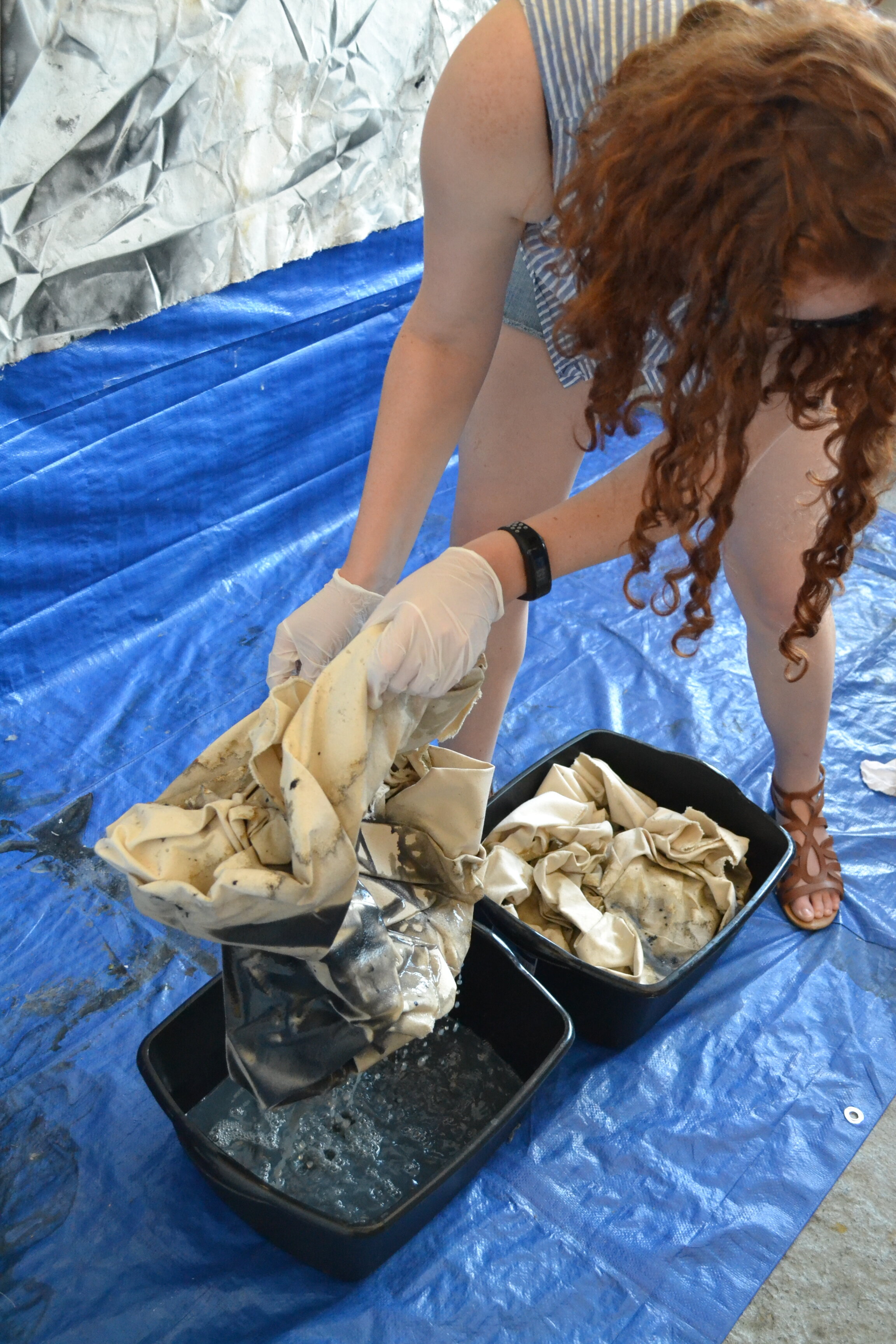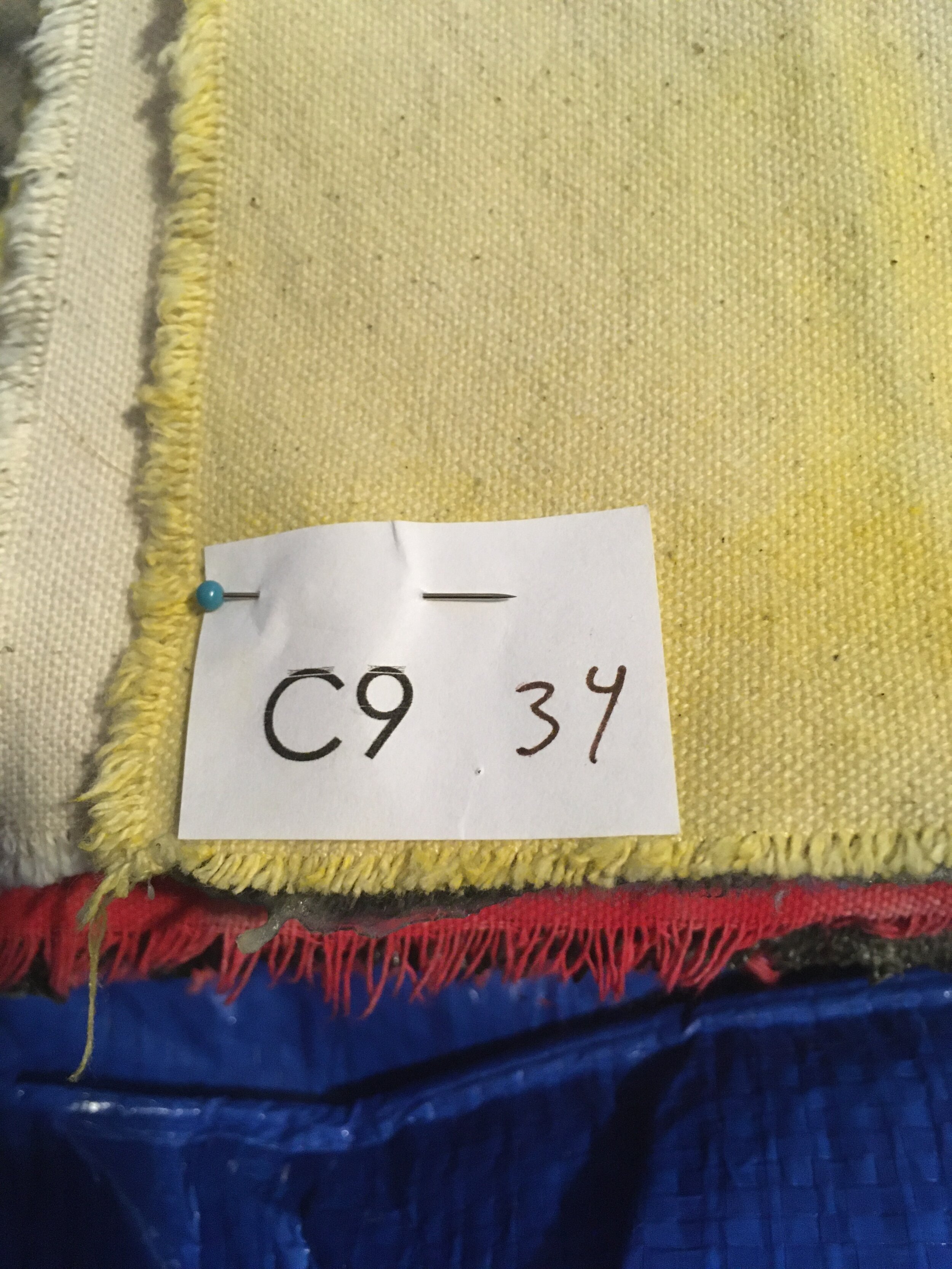With or Without You: MFA Thesis Project composed of two artworks, Alone and Help Me, 2020
With or Without You is composed of two abnormally sized books, titled Alone and Help Me. Alone is approximately 33 inches by 24 inches by 6 inches while Help Me is approximately 63 inches by 44 inches by 6 inches. The first book, Alone, weighs about fifty pounds, while the second book, Help Me, weighs about one hundred.
Alone and Help Me are constructed as sculptural paintings and challenge viewers to physically interact with the paintings. Both books are constructed from canvas, acrylic paint, clear protector paint, grommets, and thread and consist of fifty leaves, which are composed of two signatures of twenty-five leaves. Throughout these books, leaves are varied in textural and visual differences to provide a unique tactile experience.
There are six different types of leaves in the books. The first is “raw canvas”, which was left in its original state. The second type is “no coat”, which was dyed with diluted black acrylic paint and not given a clear protector coat. The third leaf type is called “one coat” which is dyed with the same acrylic paint and then given one layer of clear protector paint. The fourth is “two coats”, which resembles the “one coat” process, but has two layers of clear protector paint. The fifth leaf type is “oil paint”, which is similar to the “two coats” leaf, but is accented with diluted oil paint. The last leaf type is “color”, which is identical to “no coat”, except red, yellow, or blue dilute acrylic paints were used instead of diluted black acrylic paint. Both sides of each leaf are identical by type. Texture of leaves vary due to the amount of clear protector paint applied. “Raw canvas” and “no coat” types are the softest and most flexible, due to no clear protector paint. “One coat” types are stiffer and have reduced softness, but still have flexibility. “Two coats” leaves are rigid, although flexible and texturally resemble a heavy-duty tarp.
I started the process by cutting the canvas into leaves for both books. Alone’s leaves were cut to thirty by forty inches. Help Me’s leaves were cut to sixty by eighty inches. Then I prepared the leaves for dyeing by crunching them until I was satisfied and set them aside. Then I added about a gallon and a half of water and about 100 milliliters of acrylic paint to each tub. I used a hand blender until the paint and water were mixed well, and then immediately submerged the prepared canvases into the tubs. Two leaves for Alone or one leaf for Help Me fit in a tub. I soaked them for varied amounts of time.
I took a large tarp and secured it to a wall and the excess laid on the floor. The tarped area became the drying station for the leaves. When I removed leaves from a tub, I slowly picked one leaf at a time and let it hang over the tub to let excess solution slide off the canvas. Once it was sufficiently drained, I carefully unraveled most of the crunched leaf over the tarped area. Some leaves were pinned to the wall and others were laid on the tarp, this allowed the leaves to air dry.
Once they were dried, I ironed them one at a time by using my handmade ironing board designed specifically for this usage. The process left each leaf slightly distorted and unique, so the final form was unknown even to me until it was finally on the wall. Although a slightly repetitive and mundane process, each leaf proved to be completely unique from others created in the same manner. The seemingly endless variety in textures, dimensions, and composition resulted in a starkly unique creation.
After I ironed one side of a leaf, if it was a “no coat” or “color” type it was folded and stored, while the other three leaf types were pinned to the tarped wall awaiting completion. At this stage, I coated the remaining leaves with clear protector paint, which are “one coat”, “two coats”, and “oil paint”. I applied their respective number of coats for their types. Each coat took at least two hours to dry. Once the “one coat” and “two coats” were dried, I folded and stored them. “Oil paint” leaves had one final process; the application of diluted oil paint with a small paint brush. It took one to two weeks for the oil paint to completely dry.
Because of the dyeing process, it created different imagery on each side of the same piece of canvas, thereby creating two hundred paintings. I wanted to be able to showcase both sides of the leaves. To do so would mean converting these 2D objects into a sculptural space. My solution was binding each painting into books according to their dimensions.
After all the leaves were dried, I installed grommets to assist in creating a durable binding. I gently folded and stored the leaves until I could bind the books. I designed my own binding method using raw canvas strips with which I bound the books. The binding was designed to create “handles” for carrying the books and to create flexibility and mobility in turning the pages. With or Without You breaks book traditions. There is no cover and no restricted binding, therefore allowing them to be inverted and turned in almost any direction for viewing. Signifying that there is no beginning and no end to the problems we come across in life, as problems are endless.
I created a personal code system to resemble, yet mock page numbers. Codes were generated based by leaf type with a correlating number based on the number of leaves made for that specific leaf type. The leaf type codes are as follows: R# (raw canvas), NC# (no coat), 1C# (one coat), 2C# (two coat), OP# (oil paint), and C# (color). There are two to three characters for each code, such as: R1, NC3, 1C5, 2C8, OP4, C9. There are five raw canvas leaves and each of the remaining leaf types each have nine. That is why raw canvas types will not exceed a number five, and the other types will not exceed the number nine after the character(s). Codes are hand sewn into the leaves. The thread color used for “raw canvas” is tan and “color” has red, yellow, or blue which corresponds to the identical dyed color, while “no coat”, “one coat”, ‘”two coats”, and “oil paint” are based on a gradient scale from light grey to black. Alone characters in the codes are ¼ inch by ½ inch, while the characters in Help Me are ½ inch by 1 inch.
The order of the leaf types was randomized within the books. The placement of the codes for each leaf were also randomized out of eight potential options (four corners on each side), this allows the viewer to view and interact with it anyway they please, compared to a traditional book. This randomization was done by using an array and dice to organize and place codes and leaf types; a humanized version of an algorithm. However, control came into play when I deemed it necessary to ensure chaos. The books are also individually randomized, therefore they do not copy each other.
By using chaos and control as components in the dyeing process, the canvases achieved a Rorschach effect, allowing viewers to create personalized images in their own minds and, essentially, create a personal connection with each page. Chaos and control feed off each other through material manipulation. Systems and structures are implemented at the beginning of the process, only to be broken as the materials connect and interact. Unpredictability allows controlled decisions.
Both books will be displayed on the floor, to some extent referencing children’s books, which are commonly placed and viewed on the floor. Although the display and the sheer size of the books may be initially confusing, the display is targeting an audience of adults who, via the display, will form personal connections with the books all the way back to their childhood.
Not for sale











